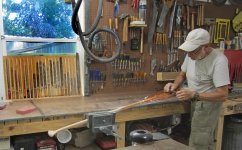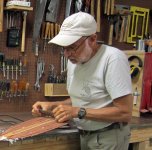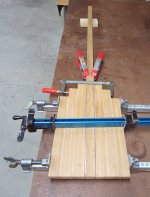-
Happy Birthday, Edmond Halley (1656-1742)! ☄️🔭
You are using an out of date browser. It may not display this or other websites correctly.
You should upgrade or use an alternative browser.
You should upgrade or use an alternative browser.
Building Canoe Paddles
- Thread starter Marc Ornstein
- Start date
Interesting, your card file looks a lot like the ones I use for alpine and Nordic ski tuning.Using a card scraper to flatten and smooth the epoxy surface of a freestyle paddle. One of several steps before final finishing.
Probably a bit stiffer but otherwise, pretty much the same. Using the card scarper instead of sandpaper is faster, cleaner, much better at flattening the surface and also a lot more satisfying to use.
True, for ski base shaping the card file is really stiff. For removing fine hairs and smoothing and for wax removal the card files I use are fairly flexible.
Marc, thanks for taking the time to post a photo essay on how you make laminated wood paddles.
Do you have a standard menu of woods you use to make a paddle, or do you vary it depending on supply, customer request, whim, or other factors?
Soon to become a paddle. All parts cut. 17 pieces plus Dynel edging (not shown).
Do you have a standard menu of woods you use to make a paddle, or do you vary it depending on supply, customer request, whim, or other factors?
Nice shop Marc. I see that you make custom paddles, how does that work?
Western red cedar is the most common wood that I use for the blades and shaft core. I also use eastern white cedar, and occasionally some repurposed redwood that I have on hand. For ultra light blades (saves and ounce +) I use paulonia.Marc, thanks for taking the time to post a photo essay on how you make laminated wood paddles.
Do you have a standard menu of woods you use to make a paddle, or do you vary it depending on supply, customer request, whim, or other factors?
The shaft facings, blade tip, grip blocks and grip cheeks are hardwood. I use a lot of walnut but also hard maple, cherry and other woods. Often the choices are made by the customer but most leave that up to me.
I have a conversation with the customer to determine their need/want. We discuss the type of paddle (river, shallow water, freestyle...). Then comes a discussion of shaft length. Sometimes their is a special request about grip size and or paddle shaft diameter. Aesthetics are always discussed, which include what woods will be used. Is it going to be a "working" paddle or a "wall hanger". Weight may not be a consideration for a wall hanger. Although all of my paddles are such that they are suitable for display, one built specifically for display may warrant a higher grade of finish. Then there is time frame ......Nice shop Marc. I see that you make custom paddles, how does that work?
I really appreciate you sharing this. What kind of glue do you use, Marc?
Similar threads
- Replies
- 16
- Views
- 424
- Replies
- 9
- Views
- 746
- Replies
- 23
- Views
- 2K





